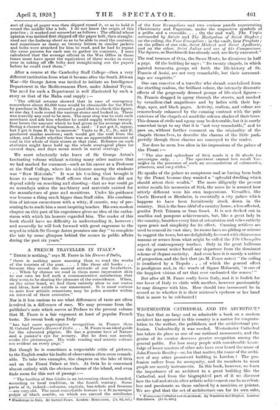WESTMINSTER CATHEDRAL AND ITS ARCHITECT.* THE fact that so large
and so admirable a book on a modern architect has appeared in this country is a matter for congratu- lation to the author, the publishers, and the architecturid pro- fession. Undoubtedly it was needed. Westminster Cathedral has taken its place as one of our national monuments, and the genius of its creator deserves greater recognition among the general public. For how many people with considerable know- ledge of lesser masters of other arts have ever heard the name of John Francis Bentley—or, for that matter, the name of the archi- tect of any other prominent building in London ? The pro- fession suffers from its anonymity, and its members to most people are merely instruments. In this book, however, we learn the importance of an architect to a great building like the Cathedral, and from the biographical part of it we discover how the toil and strain after artistic achievement can be as relent- less and passionate as those endured by a musician or painter. We are glad that the art of architecture can for its own sake, • Westminster Cathedral and Us Architect. By Winefride de l'Hopital. London: Hutchinson. Ltd dz. net.)
and even to-day, exact such a toll. For Bentley worked himself to death on his masterpiece and only lived to see it roughly completed.
The book is divided into two halves, the first volume dealing with the Cathedral entirely, and the second being a mixed biography of the architect and descriptions of his minor works. One can justifiably criticize this arrangement, for it leads to a certain amount of repetition—e.g.. Bentley's pleasure and remarks at receiving the R.I.B.A. gold medal appear in both volumes, and at the end of each one has to suffer the regnet at his comparatively early death. It would have been better perhaps if the architect had been made the principal subject, and the Cathedral, allotted to the second volume, brought in as the culmination of his work. The interest attaching to his development from rather sentimental Gothic to classical Byzan- tine work would have been more apparent. The first volume, which opens with the laying of the foundation-stone, contains everything of interest from the religious, architectural, and financial points of view. The chapter on the constructional problems the building offered is of great technical value, and is well illustrated by working drawings and photographs. That on the choice of the architect has also a special interest from the unusual way the difficulty was solved. For Bentley was unani- mously selected by his brother Roman Catholic architects for the work. It is amusing to think what would happen if, for instance, the Government asked the whole profession to act similarly in an important public work. Would the result be so wholly un- worldly? The three chapters describing the building in detail are very fully done, but in places remind one a little of a guide- book—such phrases as "Retracing his steps to the south transept and thence across the nave, the visitor will next proceed to the chapel of. . . "(p. 176). But this lapse in style is only a blemish on an otherwise excellent monograph, Which is wisely completed by a description with plans and photographs of the auxiliary buildings in Ambroaeden Avenue. These are interesting because the designing of a modern Archbishop's palace is a unique opportunity for an architect. Bentley, we think, seized It delightfully.
The second volume comprises within a space equal to the first notes both on the life and character of the architect and on his works other than the Cathedral. These were principally Roman Catholic churches and conventual buildings. Among them the church at Watford is by far the finest. They are all in the best style of the Gothic revival, bolder than Pugin's work and more imaginative than Gilbert Scott's, but—to put it delicately—we shall probably appreciate them more in a hundred years than we do at the moment. For without the Cathedral Bentley's achievement would have been merely Ordinarily good. It was the courage with which he divorced himself from his previous
4 style to the adoption of another hitherto untried, and the brilliance with which he suddenly brought that adoption to the complete fulfilment of modem requirements, which immortalize him. This book shows na that ; so it fulfils its purpose.



































 Previous page
Previous page